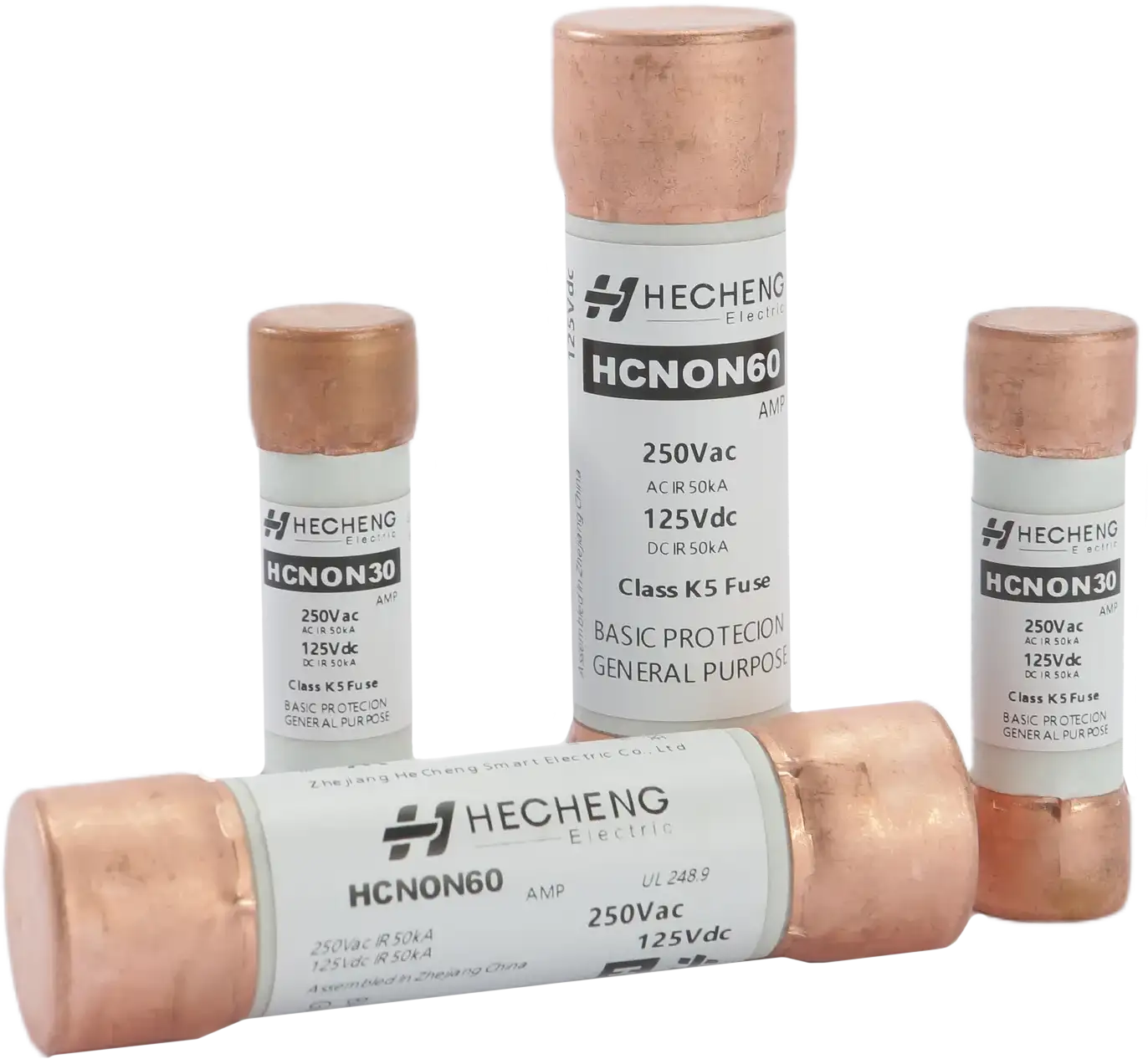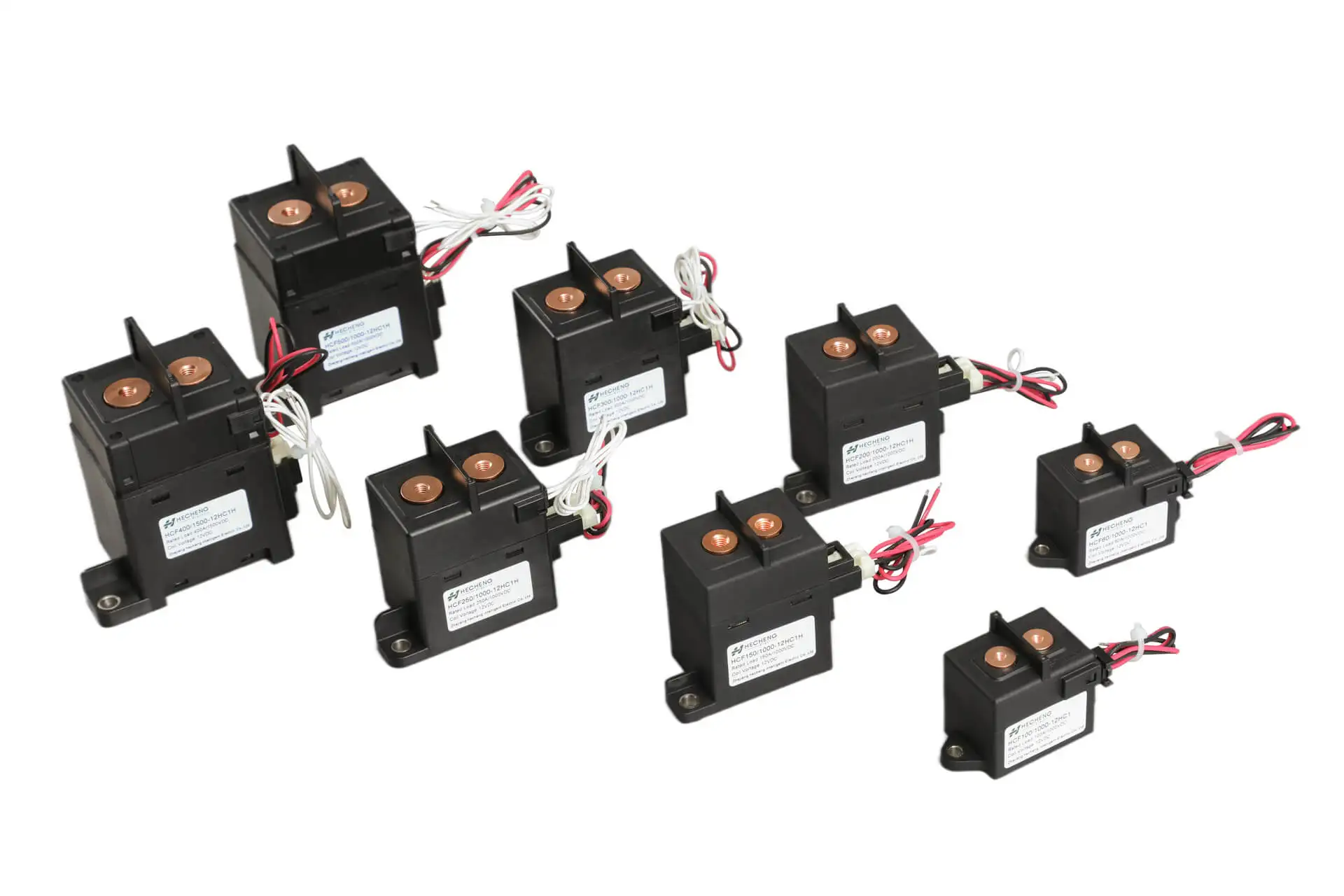Introduction to Class RK5 Fuses:
Class RK5 fuse is a specific type of fuse. It is a protective component specially designed for industrial environments. It is designed to ensure the safe and stable operation of industrial power systems. It is usually used to provide circuit overload protection. This series of products uses high-quality metal materials and special fuse technology, which has extremely high reliability and stability and can operate stably for a long time in harsh industrial environments.

One of the characteristics of Class RK5 fuses is their rapid sounding at high peak currents, which allows them to quickly cut off the circuit when a brief overload condition occurs in the circuit, minimizing equipment damage and downtime.
The second feature is its high capacity. During normal operation, it can be used to cope with some higher overload currents, maintain the normal operation of the circuit, and have a certain thermal overload capability. This series of products adopts standardized packaging and installation methods to facilitate integration and application in various industrial equipment and improve production efficiency.
Working Principle of Class RK5 Fuse:
The working principle of the Class RK5 fuse is based on the heating effect of current. When the current in the circuit exceeds the rating of the fuse, the metal wire inside the fuse will heat up due to the heating effect of the current. When the temperature reaches the melting point of the metal, the metal wire will fuse and cut off the circuit, thus protecting the safe and stable operation of the industrial power supply system.
HIITIO series Class RK5 fuse is widely used in various industrial equipment, such as motors, distribution board main power supplies and feeders, machine tools, automation equipment, production lines, and various control systems.
In terms of motor protection, it can be used as an overcurrent protection element to prevent the motor from being damaged due to short circuit or overload.
It can also protect the motor from single-phase burnout in three-phase systems. In automation equipment, it can protect sensitive circuits from overcurrent and surges. damage. In the production line, it can ensure the safe and stable operation of the production line. In the control system, it can be used as a backup protection component to improve the reliability of the control system.
How to choose a suitable Class RK5 Fuse?
1. Distinguish some common industrial fuse types
Nowadays, the circuit protection market is full of various industrial power fuses, and their corresponding certification standards also vary. You can refer to the figure below.
The difference between these industrial fuses is mainly reflected in their performance and application range. It is very important to correctly apply fuses to protect circuits in complex power systems. The following is an introduction to some common industrial fuses.
Class H fuse.
Formerly known as NEC size fuses, this barrel fuse is suitable for the protection of general branch circuits, lighting circuits, and non-inductive equipment such as toaster ovens and resistance heaters.
Class H fuses have DC ratings with relatively high short-circuit power factors: 0.45 to 0.50 for fuses rated 110A to 600A, and 0.85 to 0.90 for fuses rated 100A and below. Class H does not have a high breaking capacity and does not limit fault current, with a nominal voltage of 250 to 600V and a breaking capacity of 10kA.
Class K fuse.
These non-regenerable fuses are primarily divided into two separate categories, defined as categories K-1 and K-5. All products are available in 250VAC and 600VAC ratings, with current ratings from 0A to 600A.
All Class K fuses are current-limiting fuses, and their standards specify the maximum peak let-through current and maximum I²t let-through energy for each class. It has a DC rating and its interruption rating can be 50kA, 100kA, or 200kA rms (symmetrical).
Class K-1 fuses provide the optimum degree of current limitation. Class K-5 fuses, on the other hand, provide a lesser degree of current limitation and are specifically designed for protection against motor starting overloads.
Class R fuse.
These non-regenerable fuses are available in voltage ratings of 250VAC and 600VAC and current ratings from 0A to 600A. Class R fuses also have a DC rating. They have a 200kA rms symmetrical breaking rating and come in two different categories: RK1 and RK5.
The interrupting rating of the RK1 fuse is 300kA and the RK5 fuse is 200kA, and they have specific time-current characteristics to provide appropriate short-term overload protection when the motor is started. RK1 and RK5 fuses have a current limiting function and meet the maximum peak instantaneous let-through current and maximum I2t let-through energy requirements specified in the standard.
All Class R fuses must bear a “Current Limiting” label. They also have a “time delay” label indicating that they meet the optional time delay test and will not open for 10 seconds at 500% of the fuse’s rated current.
Class J fuse.
These non-regenerable fuses are current limiting and comply with 248-8 standards. UL Class J fuses are rated from 0A to 600A and have a voltage rating of 600VAC. Class J fuses have a DC rating. The symmetrical breaking rating is 200kA rms. Fuses are available with an interrupting rating of 300kA. If the series fuses meet UL optional time-delay test requirements (minimum 10 seconds opening time at 500% of fuse rated current), then it could use a time-delay labeling.
Class J fuses are typically used in general industrial applications and have higher breaking capacity and lower continuous current ratings. They are suitable for basic protection against circuit overloads and short circuits.
Class CC fuse.
This series of fuses could support a rated current range from 0A to 30A and, rated voltage of 600VAC. Class CC fuses have a DC rating with an interrupting capacity of 200kA. The optional time delay test requirements for this type of fuse (minimum 12 seconds opening time at 200% of the fuse’s rated current) are different from those for other larger bulk fuses.
These non-regenerable fuses have a current-limiting function and are designed to provide short-circuit protection for small motors, transformers, solenoids and inductive loads that are sensitive to short-term overloads.
2. Select appropriate fusing characteristics
Slow-Blow Fuse (Time Delay Fuse)
This fuse has a slow response speed. They can tolerate overload current for a short period and will trigger a circuit break only when the overload current continues for some time. This design makes the slow-blow fuse suitable for transient overload conditions that may occur when some loads are started, such as a high starting current when starting a motor.
The characteristic of slow-blow fuses is that they have a certain degree of thermal inertia and need to be heated for a period of time under overload conditions before they blow. Therefore, when selecting slow-blow fuses, you need to consider the starting characteristics of the load and instantaneous overload conditions.
Fast Acting Fuse
This fuse has a fast response speed. Once the current exceeds the rated value, they will trigger and cut off the circuit immediately. This design makes fast-acting fuses suitable for protecting sensitive loads and electronic equipment because they can quickly cut off the circuit and prevent equipment from being damaged by overload or short circuit.
Fast-acting fuses have fast response times, and they will trigger and interrupt the circuit as soon as the current exceeds the rated value. This design makes fast-acting fuses suitable for protecting sensitive loads and electronic equipment because they can quickly cut off the circuit and prevent equipment from being damaged by overload or short circuit.
3. Circuit characteristics matching
Discuss how to accurately select RK5 fuses according to characteristics such as load type and current fluctuation under different circuit conditions to ensure efficient operation of the circuit and safety of the equipment, mainly starting from the following aspects.
Rated current
Select the appropriate fuse rated current according to the rated current requirement of the circuit. Make sure that the rated current of the selected fuse is greater than or equal to the maximum operating current of the circuit. A rated current that is too high may cause the fuse to fail to function in the circuit, while a rated current that is too low may cause the fuse to blow frequently, affecting the normal operation of the equipment.
Rated voltage
The voltage rating of the fuse should match the voltage rating of the circuit. A rated voltage that is too low may cause the fuse to break down and fail to work properly, while a rated voltage that is too high may cause the fuse to fail to effectively cut off the circuit.
Fuse breaking capacity
Calculate the required breaking capacity based on the maximum current demand of the load and standard requirements, and ensure that the interrupting capacity of the selected fuse is greater than the maximum possible current of the load to ensure effective overload protection. Usually, the breaking capacity of the fuse should be greater than the maximum fault current of the circuit.
Installation dimensions
Be sure to ensure that the size and installation requirements of the selected fuse are appropriate for your circuit and equipment. The size of the fuse should be small enough to save space and should meet the installation requirements to ensure firm installation and good thermal conductivity.
Check out relevant standards
Check the relevant standards and codes in your area to learn about the requirements for fuse types and sizes for your specific application. For example, UL (Underwriters Laboratories) and NEC (National Electrical Code) are commonly used standards in the United States
4. Brand and supplier selection
Choose suppliers and brands with good reputations and reliable product quality. Ensure the fuses you choose meet relevant safety standards and provide good after-sales service and support.
Some Common Class RK5 Fuse Brands in the Market
Bussmann
Bussmann is a well-known brand owned by Eaton Company, focusing on the production of various types of electrical accessories and protection devices, including fuses. The FRN-R RK5 fuse is a model in the Bussmann series and has the following features:
Current range: FRN-R series class RK5 fuse current supports from 1⁄10 to 60 amps, which can be adapted to the rated current requirements of different circuits.
Current range: 250Vac and 125Vdc voltage support available.
Breaking capacity: The breaking capacity reaches 250Vac 200kA / 125Vdc 20kA, which can quickly cut off the circuit and protect the equipment from overload and short circuit.
Size: The sizes of different current segments are different. The size of the 1⁄10 to 30 amp fuse is 50.8mm*14.22mm, while the size of the 35 to 60 amp is 76.2mm*20.57mm. It is suitable for circuit board designs of different specifications.
Certification: Bussmann FRN-R series RK5 is UL, CSA, and CE certified.
In addition, FRN-R RK5 fuses provide optional fuse break indication on selected ratings to facilitate user condition monitoring and maintenance.
Its overload element provides low-level overcurrent protection against overload and will sustain an overload five times greater than the fuse’s rated current for at least ten seconds.
Mersen
Mersen is a global provider of electrical equipment and industrial solutions, focusing on the fields of electrical protection, electrical connections, thermal management and material handling. TR-R series RK5 fuses are an important product in its product line and have the following features Features:
Current Range: This RK5 fuse from Mersen offers a wide range of current, supporting 1⁄10 to 600 amps to meet a wide range of circuit needs, from small electronic devices to industrial-grade electrical systems.
Voltage support: TR-R series supports 250VAC and 250VDC (only supports 0.1-2.8A; 35-400A); 160VDC (only supports 3-30A; 450-600A).
Segmentation Capability: With a segmentation capability of 200kA I.R. AC / 20kA I.R. DC, it can reliably protect circuits from overloads and short circuits.
Size: Since the current of the RK5 fuse of the Mersen TR-R series can reach 600A, the sizes of different current segments are different to suit circuit designs of different specifications. For details, please refer to its size instructions.
Certification: TR-R series Class RK5 fuses are UL, and CSA certified.
TR-R current-limiting time-delay fuses are designed for overcurrent protection of motors, transformers, incoming equipment, feeders and branch circuits. The TR-R’s time-delay feature safely handles the harmless starting and surge currents associated with today’s motors and transformers.
Edison
Edison ECNR series RK5 fuse is a brand of Eaton. Edison creates products for the electrical and automotive industries, focusing on creating products for the electrical and automotive industries. This series of RK5 fuses has the following main features:
Current range: 1 to 60 amps, 70-600A, which can meet the rated current needs of various circuits.
Voltage range: Available in 250Vac (or less) and 150Vdc (or less), 250Vdc (225-600A) voltages, suitable for different types of circuits and application scenarios.
INTERRUPTION RATING: Features an interrupt rating of 200kA RMS Sym, capable of quickly breaking circuits and protecting equipment from overloads and short circuits.
Size: The size of the fuse from 1 to 30 amps is 50.8mm14.22mm, and the size of the fuse from 35 to 60 amps is 76.2mm20.57mm. There are many sizes of 70-600A, suitable for circuit designs of different specifications.
Certification: Passed cUL, CSA and CE certification, complying with relevant safety and quality standards to ensure product reliability and stability.
Overall, the Edison ECNR series RK5 fuse is a high-performance, reliable circuit protection device suitable for various electrical systems and application scenarios, ensuring safe and reliable circuit operation.
Vicfuse
Vicfuse is a local manufacturer brand in China, focusing on providing over-current, over-voltage, and over-heat protection products for power electronic circuits.
Current range: 1 to 600 amps, meeting the rated current needs of various circuits.
Voltage range: This brand of RK5 fuse has different voltages according to different current segments, 250VAC (0.1A-600A); 250V DC (0.1-2.8A; 35-400A), 60VDC (3-30A; 450-600A); 600V AC (0.1A-600A); 600V DC (0.1-12A; 70-600A), 300V DC (15A-60A), meeting a variety of requirements.
Interrupt Ratings: Available in a variety of interrupt ratings, they can quickly cut off circuits and protect equipment from overloads and short circuits. 250V AC, 250kA; 160V/250V DC, 20kA; 600V AC, 200kA; 300V/600V DC, 20kA
Size: The current of Vicfuse series RK5 fuses ranges from 1A to 600A, and the sizes of different current segments are different to suit circuit designs of different specifications.
Certification: Vicfuse’s RK5 fuse has not yet received relevant international certification.
HIITIO
HIITIO is a supplier brand located in Zhejiang Province, China. We have been specializing in manufacturing high-voltage DC relays, contactors, fuses and other electrical equipment for electric vehicles, solar systems and energy storage applications. HIITIO HCNR series RK5 fuses have the following features:
Current range: 1A-60A, meeting the rated current needs of various circuits.
Voltage range: Available in 250Vac and 150Vdc voltages, suitable for different types of circuits and application scenarios.
Interruption Rating: HCNR Series RK5 fuses have breaking capacities up to 250VAC 200kA / 150VDC 50kA, capable of quickly cutting off circuits and protecting equipment from overloads and short circuits.
Size: The size of HCNR series RK5 fuses is also standard. The fuse size from 1 to 30 amps is 50.8mm14.3mm, and the fuse size from 35 to 60 amps is 76.2mm20.7mm. It is suitable for circuit board designs of different specifications.
Certification: Obtained UL certification.
HCNR series RK5 fuses can withstand large currents during normal operation and maintain normal operation of the circuit. It can be used in circuits affected by temporary motor overloads and surge currents to provide high performance short circuit and overload protection. The overload element provides protection against low-level overcurrent overload and will maintain an overload exceeding 5 times the fuse ampere rating for at least 10 seconds.
HIITIO Advantages
Regarding certification, HIITIO has currently passed UL certification, UL No. E537893. This is the only UL-certified manufacturer in China, which means that this series of products complies with UL248-12 standards and has reliable safety performance and quality assurance.
Regarding performance, HIITIO series RK5 fuses from 1-60A can completely replace well-known brand fuses, showing excellent levels in terms of segmentation capabilities and performance. 250/150V fuses are easy to install and replace, using standard sizes and terminal blocks, can be easily installed in various electrical equipment and systems, and users can easily replace the fuses, greatly reducing maintenance and downtime.
Regarding price and quality, since HIITIO is a company integrating industry and trade, we can provide competitive factory prices. At the same time, HIITIO Class RK5 fuse has high temperature stability and is not easy to blow. The main material selection and design enable it to effectively prevent overheating and In the event of a fire, protect the safe operation of circuits and electrical equipment, reduce the risk of damage to electrical equipment, and improve the safety of the entire system. In addition, we can also provide OEM and ODM services according to customer needs and carry out customized production.
Regarding R&D strength, As a manufacturer integrating industry and trade, HIITIO has its own laboratory and R&D team. This allows us to provide a full range of technical support and more guaranteed after-sales, and we have been continuously increasing investment in research and development to ensure a richer product series in the future.




